Public Health Evaluation Report: Australian Health Care Program
VerifiedAdded on 2020/03/28
|13
|3628
|114
Report
AI Summary
This report provides a comprehensive evaluation of public health programs, focusing on the importance of health program evaluation for effective public health management. It begins by summarizing the work of Pawson and Tilley on realist evaluation, outlining their methodology and key findings. The report then compares Pawson and Tilley's approach with that of Michelle Iselle, highlighting similarities and differences in their evaluation methods. Furthermore, the report delves into a case study of the Australian Aboriginal health program, specifically analyzing the 'Closing the Gap' initiative. It examines the program's objectives, actions taken, strengths, and weaknesses, offering a critical assessment of its effectiveness in addressing health disparities within the Aboriginal community. The report emphasizes the importance of culturally sensitive care, evidence-based practices, and continuous evaluation to improve health outcomes and reduce health inequalities. The report also provides a detailed analysis of the effectiveness of the health care initiatives taken and the key achievements of this program. Finally, the report provides an evaluation of the healthcare program and its initiatives.
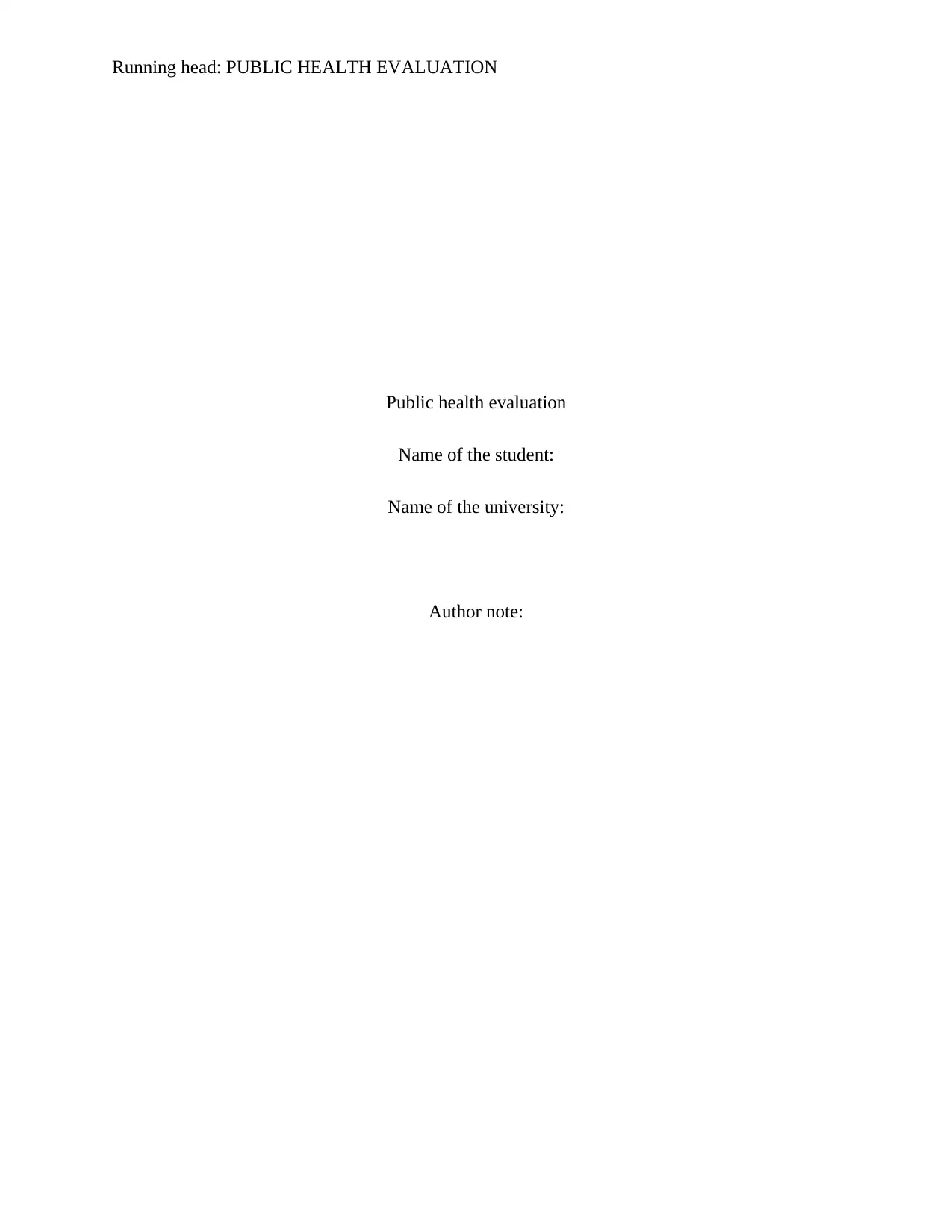
Running head: PUBLIC HEALTH EVALUATION
Public health evaluation
Name of the student:
Name of the university:
Author note:
Public health evaluation
Name of the student:
Name of the university:
Author note:
Paraphrase This Document
Need a fresh take? Get an instant paraphrase of this document with our AI Paraphraser
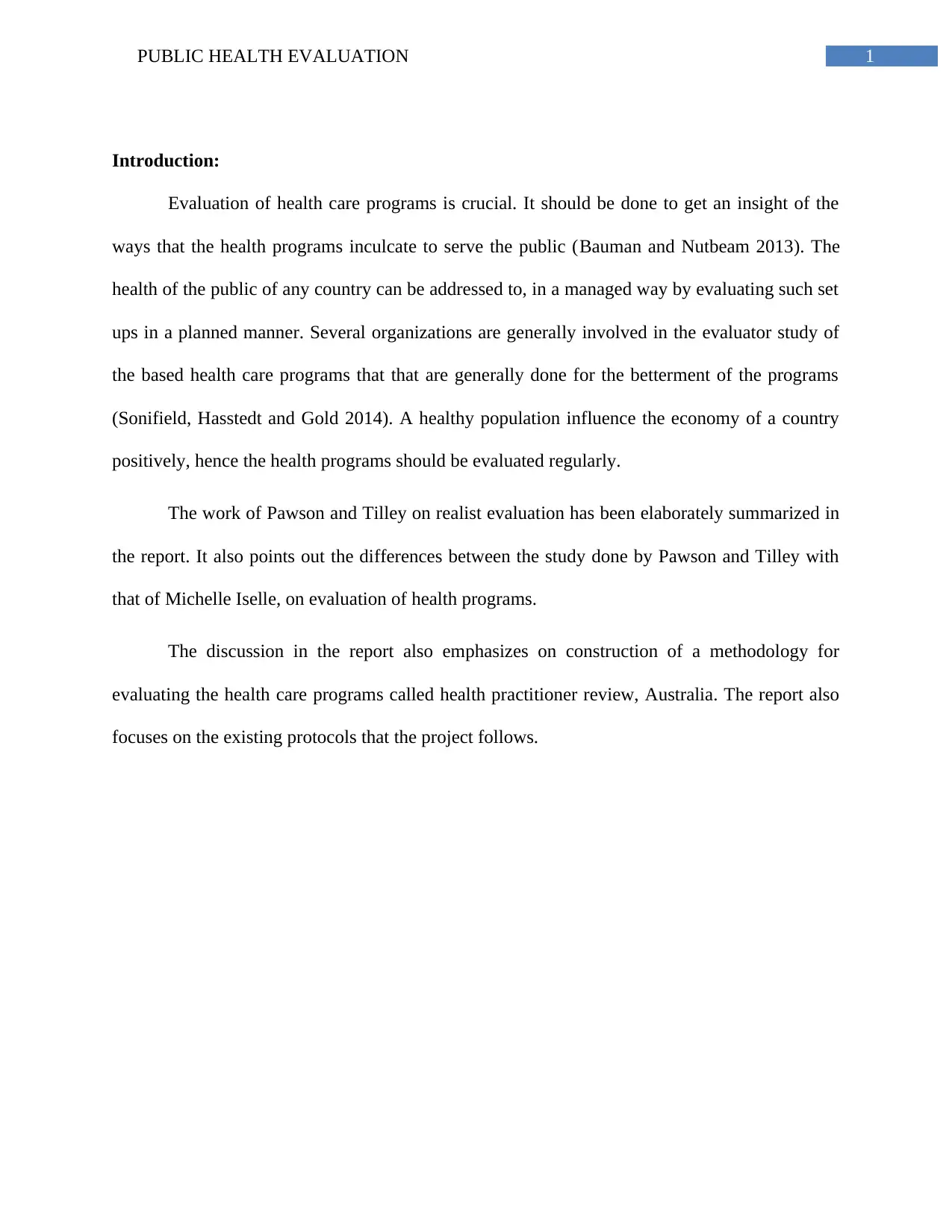
1PUBLIC HEALTH EVALUATION
Introduction:
Evaluation of health care programs is crucial. It should be done to get an insight of the
ways that the health programs inculcate to serve the public (Bauman and Nutbeam 2013). The
health of the public of any country can be addressed to, in a managed way by evaluating such set
ups in a planned manner. Several organizations are generally involved in the evaluator study of
the based health care programs that that are generally done for the betterment of the programs
(Sonifield, Hasstedt and Gold 2014). A healthy population influence the economy of a country
positively, hence the health programs should be evaluated regularly.
The work of Pawson and Tilley on realist evaluation has been elaborately summarized in
the report. It also points out the differences between the study done by Pawson and Tilley with
that of Michelle Iselle, on evaluation of health programs.
The discussion in the report also emphasizes on construction of a methodology for
evaluating the health care programs called health practitioner review, Australia. The report also
focuses on the existing protocols that the project follows.
Introduction:
Evaluation of health care programs is crucial. It should be done to get an insight of the
ways that the health programs inculcate to serve the public (Bauman and Nutbeam 2013). The
health of the public of any country can be addressed to, in a managed way by evaluating such set
ups in a planned manner. Several organizations are generally involved in the evaluator study of
the based health care programs that that are generally done for the betterment of the programs
(Sonifield, Hasstedt and Gold 2014). A healthy population influence the economy of a country
positively, hence the health programs should be evaluated regularly.
The work of Pawson and Tilley on realist evaluation has been elaborately summarized in
the report. It also points out the differences between the study done by Pawson and Tilley with
that of Michelle Iselle, on evaluation of health programs.
The discussion in the report also emphasizes on construction of a methodology for
evaluating the health care programs called health practitioner review, Australia. The report also
focuses on the existing protocols that the project follows.
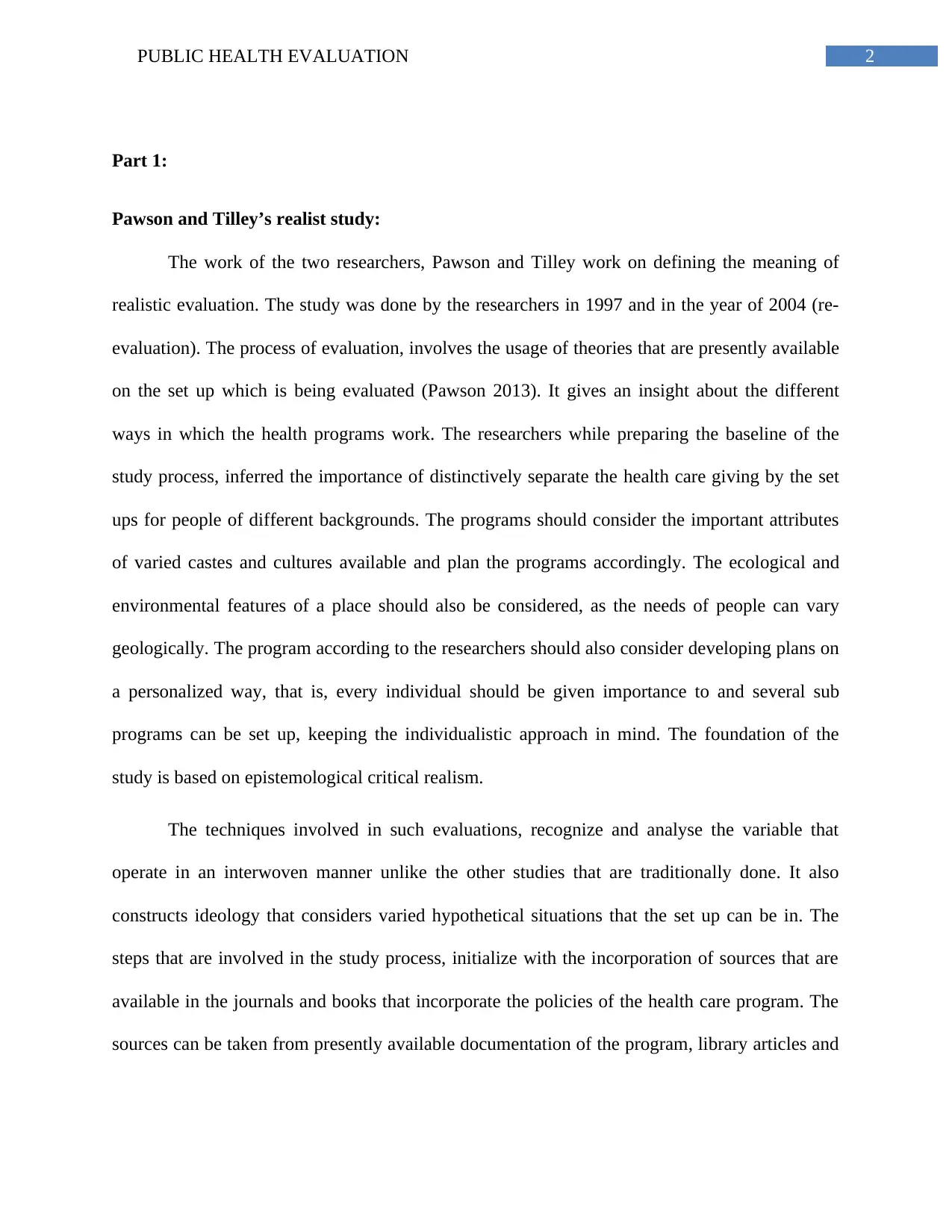
2PUBLIC HEALTH EVALUATION
Part 1:
Pawson and Tilley’s realist study:
The work of the two researchers, Pawson and Tilley work on defining the meaning of
realistic evaluation. The study was done by the researchers in 1997 and in the year of 2004 (re-
evaluation). The process of evaluation, involves the usage of theories that are presently available
on the set up which is being evaluated (Pawson 2013). It gives an insight about the different
ways in which the health programs work. The researchers while preparing the baseline of the
study process, inferred the importance of distinctively separate the health care giving by the set
ups for people of different backgrounds. The programs should consider the important attributes
of varied castes and cultures available and plan the programs accordingly. The ecological and
environmental features of a place should also be considered, as the needs of people can vary
geologically. The program according to the researchers should also consider developing plans on
a personalized way, that is, every individual should be given importance to and several sub
programs can be set up, keeping the individualistic approach in mind. The foundation of the
study is based on epistemological critical realism.
The techniques involved in such evaluations, recognize and analyse the variable that
operate in an interwoven manner unlike the other studies that are traditionally done. It also
constructs ideology that considers varied hypothetical situations that the set up can be in. The
steps that are involved in the study process, initialize with the incorporation of sources that are
available in the journals and books that incorporate the policies of the health care program. The
sources can be taken from presently available documentation of the program, library articles and
Part 1:
Pawson and Tilley’s realist study:
The work of the two researchers, Pawson and Tilley work on defining the meaning of
realistic evaluation. The study was done by the researchers in 1997 and in the year of 2004 (re-
evaluation). The process of evaluation, involves the usage of theories that are presently available
on the set up which is being evaluated (Pawson 2013). It gives an insight about the different
ways in which the health programs work. The researchers while preparing the baseline of the
study process, inferred the importance of distinctively separate the health care giving by the set
ups for people of different backgrounds. The programs should consider the important attributes
of varied castes and cultures available and plan the programs accordingly. The ecological and
environmental features of a place should also be considered, as the needs of people can vary
geologically. The program according to the researchers should also consider developing plans on
a personalized way, that is, every individual should be given importance to and several sub
programs can be set up, keeping the individualistic approach in mind. The foundation of the
study is based on epistemological critical realism.
The techniques involved in such evaluations, recognize and analyse the variable that
operate in an interwoven manner unlike the other studies that are traditionally done. It also
constructs ideology that considers varied hypothetical situations that the set up can be in. The
steps that are involved in the study process, initialize with the incorporation of sources that are
available in the journals and books that incorporate the policies of the health care program. The
sources can be taken from presently available documentation of the program, library articles and
⊘ This is a preview!⊘
Do you want full access?
Subscribe today to unlock all pages.

Trusted by 1+ million students worldwide
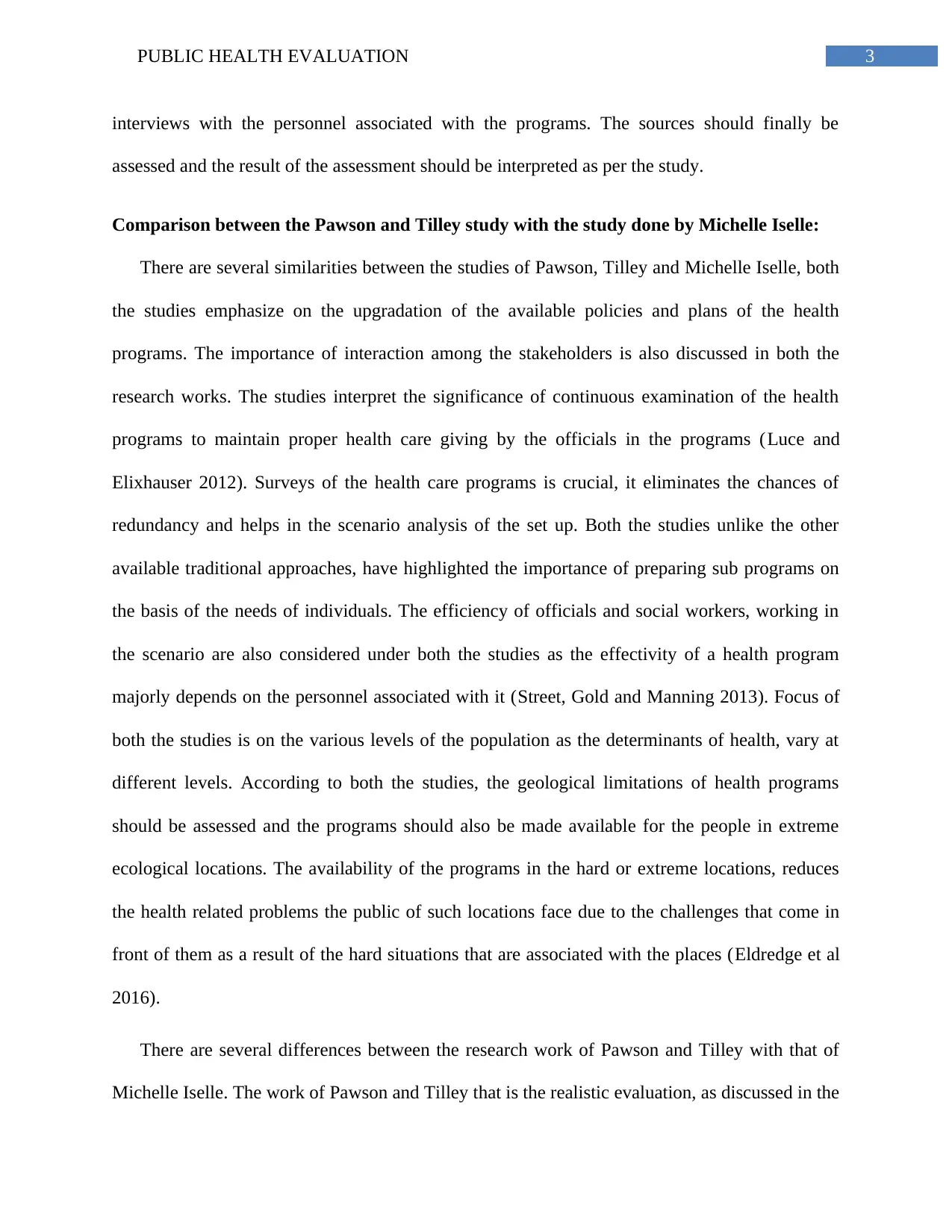
3PUBLIC HEALTH EVALUATION
interviews with the personnel associated with the programs. The sources should finally be
assessed and the result of the assessment should be interpreted as per the study.
Comparison between the Pawson and Tilley study with the study done by Michelle Iselle:
There are several similarities between the studies of Pawson, Tilley and Michelle Iselle, both
the studies emphasize on the upgradation of the available policies and plans of the health
programs. The importance of interaction among the stakeholders is also discussed in both the
research works. The studies interpret the significance of continuous examination of the health
programs to maintain proper health care giving by the officials in the programs (Luce and
Elixhauser 2012). Surveys of the health care programs is crucial, it eliminates the chances of
redundancy and helps in the scenario analysis of the set up. Both the studies unlike the other
available traditional approaches, have highlighted the importance of preparing sub programs on
the basis of the needs of individuals. The efficiency of officials and social workers, working in
the scenario are also considered under both the studies as the effectivity of a health program
majorly depends on the personnel associated with it (Street, Gold and Manning 2013). Focus of
both the studies is on the various levels of the population as the determinants of health, vary at
different levels. According to both the studies, the geological limitations of health programs
should be assessed and the programs should also be made available for the people in extreme
ecological locations. The availability of the programs in the hard or extreme locations, reduces
the health related problems the public of such locations face due to the challenges that come in
front of them as a result of the hard situations that are associated with the places (Eldredge et al
2016).
There are several differences between the research work of Pawson and Tilley with that of
Michelle Iselle. The work of Pawson and Tilley that is the realistic evaluation, as discussed in the
interviews with the personnel associated with the programs. The sources should finally be
assessed and the result of the assessment should be interpreted as per the study.
Comparison between the Pawson and Tilley study with the study done by Michelle Iselle:
There are several similarities between the studies of Pawson, Tilley and Michelle Iselle, both
the studies emphasize on the upgradation of the available policies and plans of the health
programs. The importance of interaction among the stakeholders is also discussed in both the
research works. The studies interpret the significance of continuous examination of the health
programs to maintain proper health care giving by the officials in the programs (Luce and
Elixhauser 2012). Surveys of the health care programs is crucial, it eliminates the chances of
redundancy and helps in the scenario analysis of the set up. Both the studies unlike the other
available traditional approaches, have highlighted the importance of preparing sub programs on
the basis of the needs of individuals. The efficiency of officials and social workers, working in
the scenario are also considered under both the studies as the effectivity of a health program
majorly depends on the personnel associated with it (Street, Gold and Manning 2013). Focus of
both the studies is on the various levels of the population as the determinants of health, vary at
different levels. According to both the studies, the geological limitations of health programs
should be assessed and the programs should also be made available for the people in extreme
ecological locations. The availability of the programs in the hard or extreme locations, reduces
the health related problems the public of such locations face due to the challenges that come in
front of them as a result of the hard situations that are associated with the places (Eldredge et al
2016).
There are several differences between the research work of Pawson and Tilley with that of
Michelle Iselle. The work of Pawson and Tilley that is the realistic evaluation, as discussed in the
Paraphrase This Document
Need a fresh take? Get an instant paraphrase of this document with our AI Paraphraser
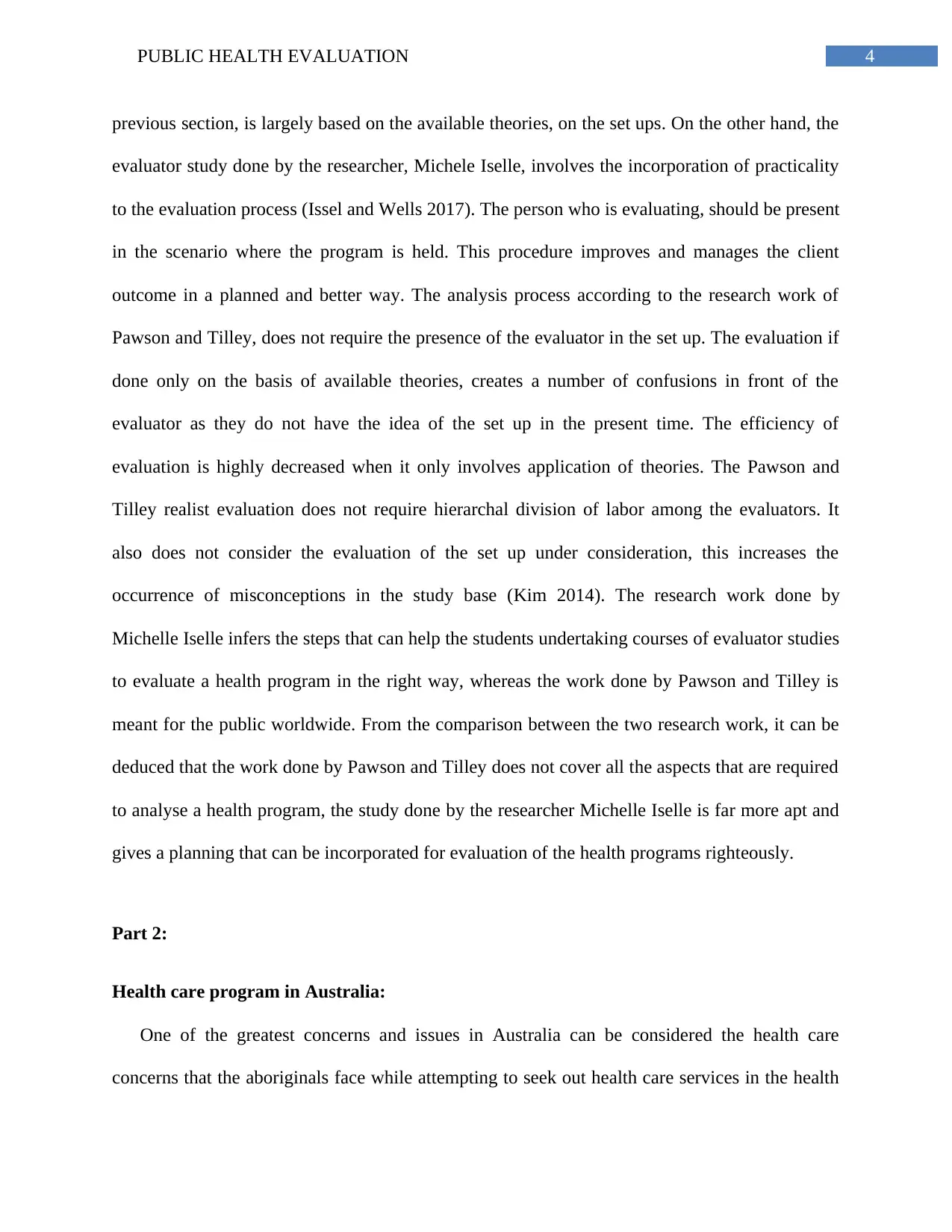
4PUBLIC HEALTH EVALUATION
previous section, is largely based on the available theories, on the set ups. On the other hand, the
evaluator study done by the researcher, Michele Iselle, involves the incorporation of practicality
to the evaluation process (Issel and Wells 2017). The person who is evaluating, should be present
in the scenario where the program is held. This procedure improves and manages the client
outcome in a planned and better way. The analysis process according to the research work of
Pawson and Tilley, does not require the presence of the evaluator in the set up. The evaluation if
done only on the basis of available theories, creates a number of confusions in front of the
evaluator as they do not have the idea of the set up in the present time. The efficiency of
evaluation is highly decreased when it only involves application of theories. The Pawson and
Tilley realist evaluation does not require hierarchal division of labor among the evaluators. It
also does not consider the evaluation of the set up under consideration, this increases the
occurrence of misconceptions in the study base (Kim 2014). The research work done by
Michelle Iselle infers the steps that can help the students undertaking courses of evaluator studies
to evaluate a health program in the right way, whereas the work done by Pawson and Tilley is
meant for the public worldwide. From the comparison between the two research work, it can be
deduced that the work done by Pawson and Tilley does not cover all the aspects that are required
to analyse a health program, the study done by the researcher Michelle Iselle is far more apt and
gives a planning that can be incorporated for evaluation of the health programs righteously.
Part 2:
Health care program in Australia:
One of the greatest concerns and issues in Australia can be considered the health care
concerns that the aboriginals face while attempting to seek out health care services in the health
previous section, is largely based on the available theories, on the set ups. On the other hand, the
evaluator study done by the researcher, Michele Iselle, involves the incorporation of practicality
to the evaluation process (Issel and Wells 2017). The person who is evaluating, should be present
in the scenario where the program is held. This procedure improves and manages the client
outcome in a planned and better way. The analysis process according to the research work of
Pawson and Tilley, does not require the presence of the evaluator in the set up. The evaluation if
done only on the basis of available theories, creates a number of confusions in front of the
evaluator as they do not have the idea of the set up in the present time. The efficiency of
evaluation is highly decreased when it only involves application of theories. The Pawson and
Tilley realist evaluation does not require hierarchal division of labor among the evaluators. It
also does not consider the evaluation of the set up under consideration, this increases the
occurrence of misconceptions in the study base (Kim 2014). The research work done by
Michelle Iselle infers the steps that can help the students undertaking courses of evaluator studies
to evaluate a health program in the right way, whereas the work done by Pawson and Tilley is
meant for the public worldwide. From the comparison between the two research work, it can be
deduced that the work done by Pawson and Tilley does not cover all the aspects that are required
to analyse a health program, the study done by the researcher Michelle Iselle is far more apt and
gives a planning that can be incorporated for evaluation of the health programs righteously.
Part 2:
Health care program in Australia:
One of the greatest concerns and issues in Australia can be considered the health care
concerns that the aboriginals face while attempting to seek out health care services in the health
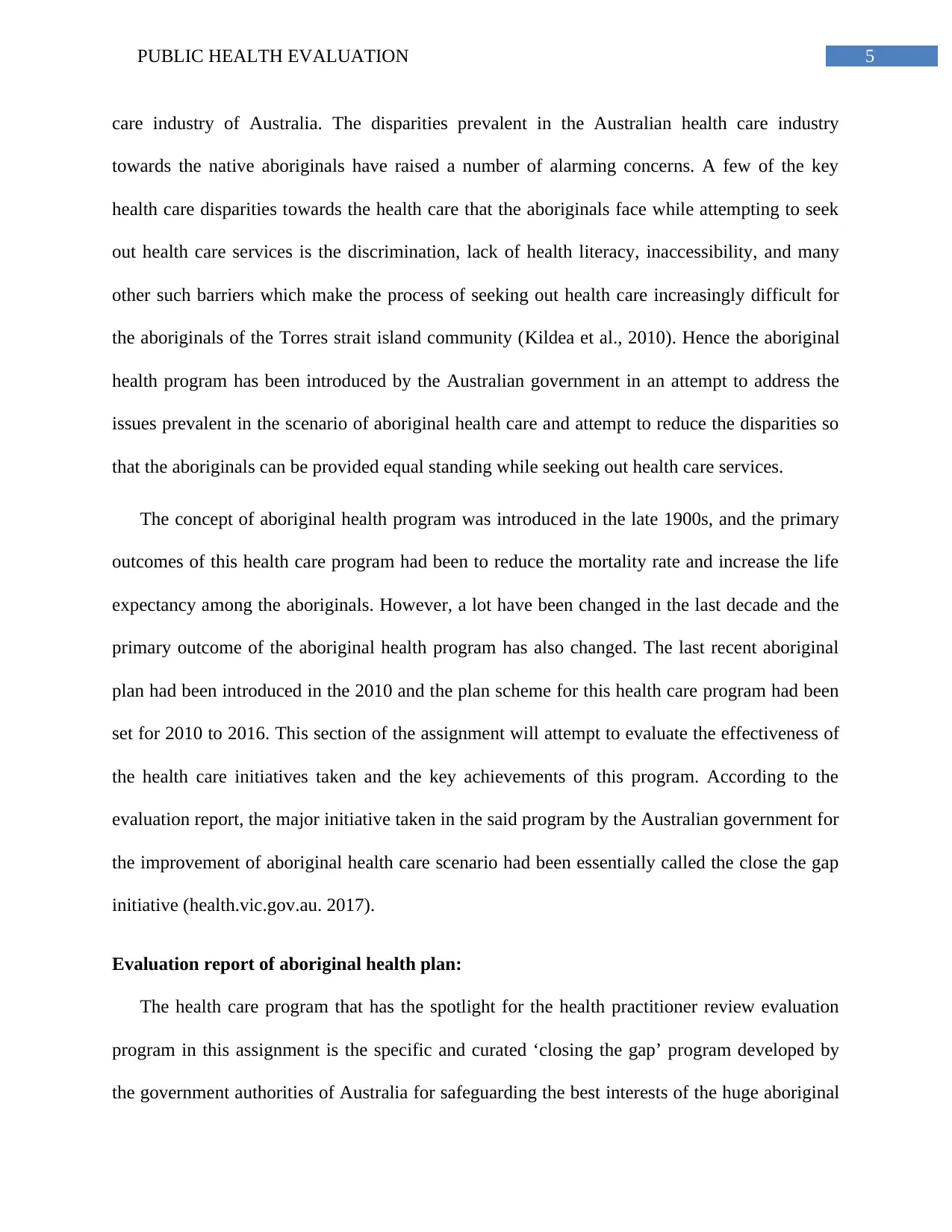
5PUBLIC HEALTH EVALUATION
care industry of Australia. The disparities prevalent in the Australian health care industry
towards the native aboriginals have raised a number of alarming concerns. A few of the key
health care disparities towards the health care that the aboriginals face while attempting to seek
out health care services is the discrimination, lack of health literacy, inaccessibility, and many
other such barriers which make the process of seeking out health care increasingly difficult for
the aboriginals of the Torres strait island community (Kildea et al., 2010). Hence the aboriginal
health program has been introduced by the Australian government in an attempt to address the
issues prevalent in the scenario of aboriginal health care and attempt to reduce the disparities so
that the aboriginals can be provided equal standing while seeking out health care services.
The concept of aboriginal health program was introduced in the late 1900s, and the primary
outcomes of this health care program had been to reduce the mortality rate and increase the life
expectancy among the aboriginals. However, a lot have been changed in the last decade and the
primary outcome of the aboriginal health program has also changed. The last recent aboriginal
plan had been introduced in the 2010 and the plan scheme for this health care program had been
set for 2010 to 2016. This section of the assignment will attempt to evaluate the effectiveness of
the health care initiatives taken and the key achievements of this program. According to the
evaluation report, the major initiative taken in the said program by the Australian government for
the improvement of aboriginal health care scenario had been essentially called the close the gap
initiative (health.vic.gov.au. 2017).
Evaluation report of aboriginal health plan:
The health care program that has the spotlight for the health practitioner review evaluation
program in this assignment is the specific and curated ‘closing the gap’ program developed by
the government authorities of Australia for safeguarding the best interests of the huge aboriginal
care industry of Australia. The disparities prevalent in the Australian health care industry
towards the native aboriginals have raised a number of alarming concerns. A few of the key
health care disparities towards the health care that the aboriginals face while attempting to seek
out health care services is the discrimination, lack of health literacy, inaccessibility, and many
other such barriers which make the process of seeking out health care increasingly difficult for
the aboriginals of the Torres strait island community (Kildea et al., 2010). Hence the aboriginal
health program has been introduced by the Australian government in an attempt to address the
issues prevalent in the scenario of aboriginal health care and attempt to reduce the disparities so
that the aboriginals can be provided equal standing while seeking out health care services.
The concept of aboriginal health program was introduced in the late 1900s, and the primary
outcomes of this health care program had been to reduce the mortality rate and increase the life
expectancy among the aboriginals. However, a lot have been changed in the last decade and the
primary outcome of the aboriginal health program has also changed. The last recent aboriginal
plan had been introduced in the 2010 and the plan scheme for this health care program had been
set for 2010 to 2016. This section of the assignment will attempt to evaluate the effectiveness of
the health care initiatives taken and the key achievements of this program. According to the
evaluation report, the major initiative taken in the said program by the Australian government for
the improvement of aboriginal health care scenario had been essentially called the close the gap
initiative (health.vic.gov.au. 2017).
Evaluation report of aboriginal health plan:
The health care program that has the spotlight for the health practitioner review evaluation
program in this assignment is the specific and curated ‘closing the gap’ program developed by
the government authorities of Australia for safeguarding the best interests of the huge aboriginal
⊘ This is a preview!⊘
Do you want full access?
Subscribe today to unlock all pages.

Trusted by 1+ million students worldwide
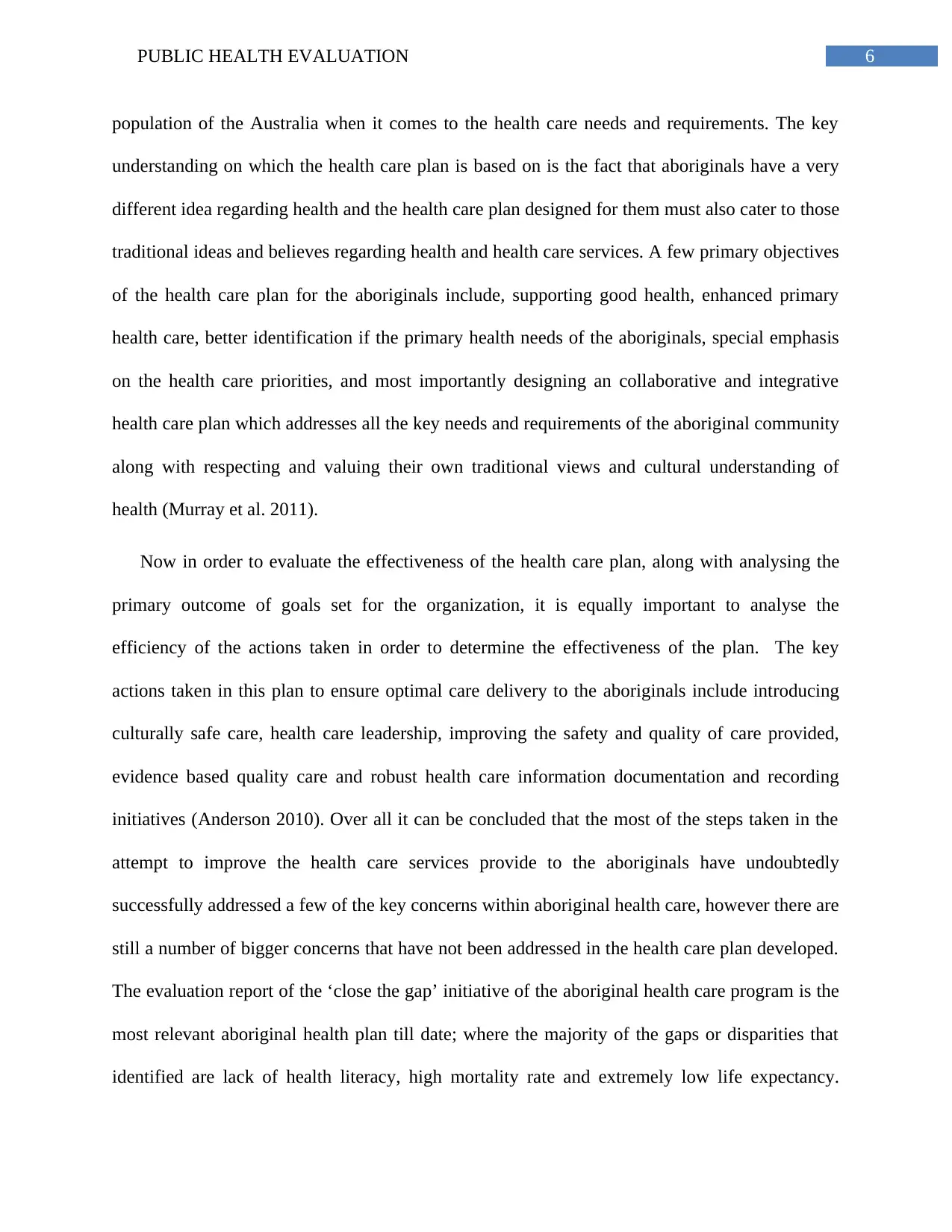
6PUBLIC HEALTH EVALUATION
population of the Australia when it comes to the health care needs and requirements. The key
understanding on which the health care plan is based on is the fact that aboriginals have a very
different idea regarding health and the health care plan designed for them must also cater to those
traditional ideas and believes regarding health and health care services. A few primary objectives
of the health care plan for the aboriginals include, supporting good health, enhanced primary
health care, better identification if the primary health needs of the aboriginals, special emphasis
on the health care priorities, and most importantly designing an collaborative and integrative
health care plan which addresses all the key needs and requirements of the aboriginal community
along with respecting and valuing their own traditional views and cultural understanding of
health (Murray et al. 2011).
Now in order to evaluate the effectiveness of the health care plan, along with analysing the
primary outcome of goals set for the organization, it is equally important to analyse the
efficiency of the actions taken in order to determine the effectiveness of the plan. The key
actions taken in this plan to ensure optimal care delivery to the aboriginals include introducing
culturally safe care, health care leadership, improving the safety and quality of care provided,
evidence based quality care and robust health care information documentation and recording
initiatives (Anderson 2010). Over all it can be concluded that the most of the steps taken in the
attempt to improve the health care services provide to the aboriginals have undoubtedly
successfully addressed a few of the key concerns within aboriginal health care, however there are
still a number of bigger concerns that have not been addressed in the health care plan developed.
The evaluation report of the ‘close the gap’ initiative of the aboriginal health care program is the
most relevant aboriginal health plan till date; where the majority of the gaps or disparities that
identified are lack of health literacy, high mortality rate and extremely low life expectancy.
population of the Australia when it comes to the health care needs and requirements. The key
understanding on which the health care plan is based on is the fact that aboriginals have a very
different idea regarding health and the health care plan designed for them must also cater to those
traditional ideas and believes regarding health and health care services. A few primary objectives
of the health care plan for the aboriginals include, supporting good health, enhanced primary
health care, better identification if the primary health needs of the aboriginals, special emphasis
on the health care priorities, and most importantly designing an collaborative and integrative
health care plan which addresses all the key needs and requirements of the aboriginal community
along with respecting and valuing their own traditional views and cultural understanding of
health (Murray et al. 2011).
Now in order to evaluate the effectiveness of the health care plan, along with analysing the
primary outcome of goals set for the organization, it is equally important to analyse the
efficiency of the actions taken in order to determine the effectiveness of the plan. The key
actions taken in this plan to ensure optimal care delivery to the aboriginals include introducing
culturally safe care, health care leadership, improving the safety and quality of care provided,
evidence based quality care and robust health care information documentation and recording
initiatives (Anderson 2010). Over all it can be concluded that the most of the steps taken in the
attempt to improve the health care services provide to the aboriginals have undoubtedly
successfully addressed a few of the key concerns within aboriginal health care, however there are
still a number of bigger concerns that have not been addressed in the health care plan developed.
The evaluation report of the ‘close the gap’ initiative of the aboriginal health care program is the
most relevant aboriginal health plan till date; where the majority of the gaps or disparities that
identified are lack of health literacy, high mortality rate and extremely low life expectancy.
Paraphrase This Document
Need a fresh take? Get an instant paraphrase of this document with our AI Paraphraser
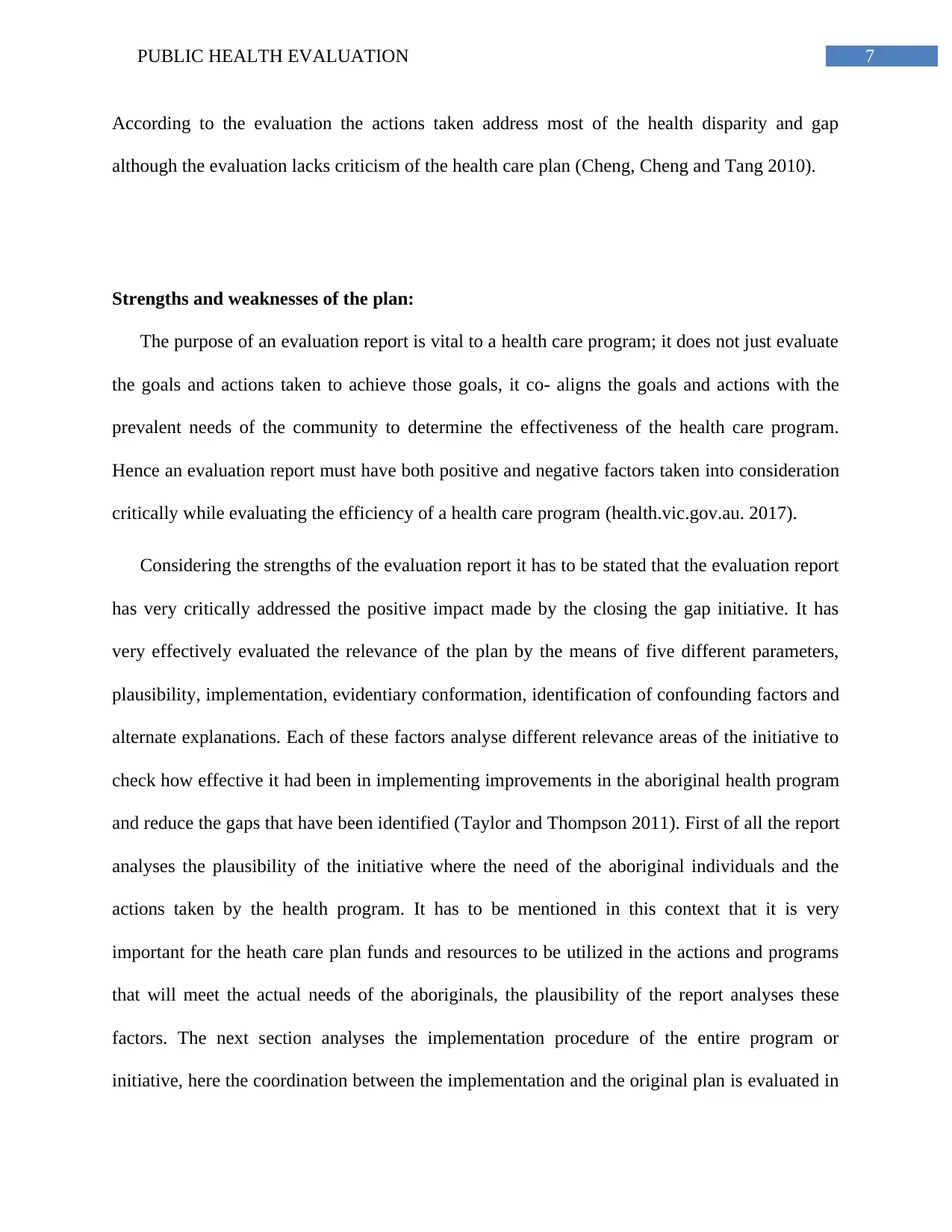
7PUBLIC HEALTH EVALUATION
According to the evaluation the actions taken address most of the health disparity and gap
although the evaluation lacks criticism of the health care plan (Cheng, Cheng and Tang 2010).
Strengths and weaknesses of the plan:
The purpose of an evaluation report is vital to a health care program; it does not just evaluate
the goals and actions taken to achieve those goals, it co- aligns the goals and actions with the
prevalent needs of the community to determine the effectiveness of the health care program.
Hence an evaluation report must have both positive and negative factors taken into consideration
critically while evaluating the efficiency of a health care program (health.vic.gov.au. 2017).
Considering the strengths of the evaluation report it has to be stated that the evaluation report
has very critically addressed the positive impact made by the closing the gap initiative. It has
very effectively evaluated the relevance of the plan by the means of five different parameters,
plausibility, implementation, evidentiary conformation, identification of confounding factors and
alternate explanations. Each of these factors analyse different relevance areas of the initiative to
check how effective it had been in implementing improvements in the aboriginal health program
and reduce the gaps that have been identified (Taylor and Thompson 2011). First of all the report
analyses the plausibility of the initiative where the need of the aboriginal individuals and the
actions taken by the health program. It has to be mentioned in this context that it is very
important for the heath care plan funds and resources to be utilized in the actions and programs
that will meet the actual needs of the aboriginals, the plausibility of the report analyses these
factors. The next section analyses the implementation procedure of the entire program or
initiative, here the coordination between the implementation and the original plan is evaluated in
According to the evaluation the actions taken address most of the health disparity and gap
although the evaluation lacks criticism of the health care plan (Cheng, Cheng and Tang 2010).
Strengths and weaknesses of the plan:
The purpose of an evaluation report is vital to a health care program; it does not just evaluate
the goals and actions taken to achieve those goals, it co- aligns the goals and actions with the
prevalent needs of the community to determine the effectiveness of the health care program.
Hence an evaluation report must have both positive and negative factors taken into consideration
critically while evaluating the efficiency of a health care program (health.vic.gov.au. 2017).
Considering the strengths of the evaluation report it has to be stated that the evaluation report
has very critically addressed the positive impact made by the closing the gap initiative. It has
very effectively evaluated the relevance of the plan by the means of five different parameters,
plausibility, implementation, evidentiary conformation, identification of confounding factors and
alternate explanations. Each of these factors analyse different relevance areas of the initiative to
check how effective it had been in implementing improvements in the aboriginal health program
and reduce the gaps that have been identified (Taylor and Thompson 2011). First of all the report
analyses the plausibility of the initiative where the need of the aboriginal individuals and the
actions taken by the health program. It has to be mentioned in this context that it is very
important for the heath care plan funds and resources to be utilized in the actions and programs
that will meet the actual needs of the aboriginals, the plausibility of the report analyses these
factors. The next section analyses the implementation procedure of the entire program or
initiative, here the coordination between the implementation and the original plan is evaluated in
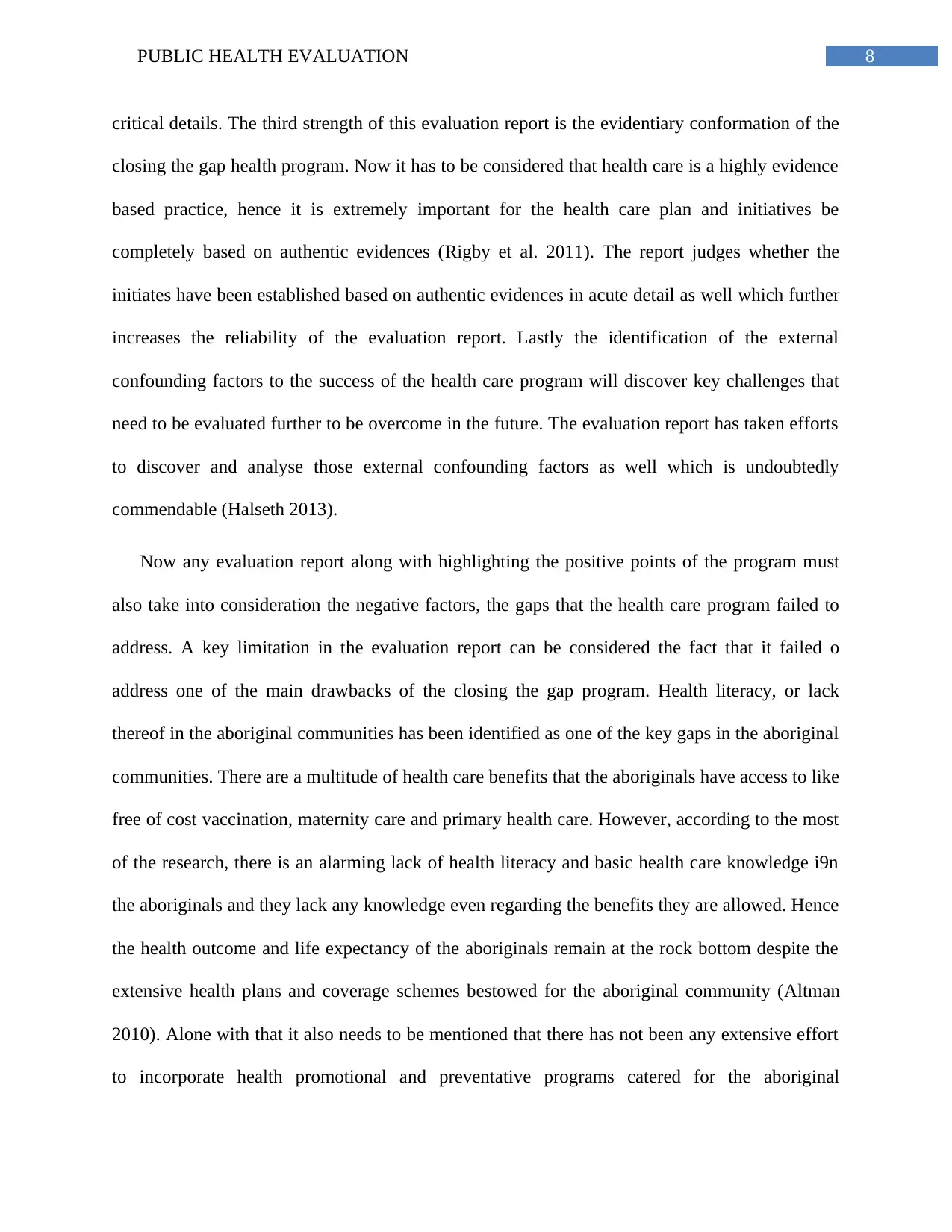
8PUBLIC HEALTH EVALUATION
critical details. The third strength of this evaluation report is the evidentiary conformation of the
closing the gap health program. Now it has to be considered that health care is a highly evidence
based practice, hence it is extremely important for the health care plan and initiatives be
completely based on authentic evidences (Rigby et al. 2011). The report judges whether the
initiates have been established based on authentic evidences in acute detail as well which further
increases the reliability of the evaluation report. Lastly the identification of the external
confounding factors to the success of the health care program will discover key challenges that
need to be evaluated further to be overcome in the future. The evaluation report has taken efforts
to discover and analyse those external confounding factors as well which is undoubtedly
commendable (Halseth 2013).
Now any evaluation report along with highlighting the positive points of the program must
also take into consideration the negative factors, the gaps that the health care program failed to
address. A key limitation in the evaluation report can be considered the fact that it failed o
address one of the main drawbacks of the closing the gap program. Health literacy, or lack
thereof in the aboriginal communities has been identified as one of the key gaps in the aboriginal
communities. There are a multitude of health care benefits that the aboriginals have access to like
free of cost vaccination, maternity care and primary health care. However, according to the most
of the research, there is an alarming lack of health literacy and basic health care knowledge i9n
the aboriginals and they lack any knowledge even regarding the benefits they are allowed. Hence
the health outcome and life expectancy of the aboriginals remain at the rock bottom despite the
extensive health plans and coverage schemes bestowed for the aboriginal community (Altman
2010). Alone with that it also needs to be mentioned that there has not been any extensive effort
to incorporate health promotional and preventative programs catered for the aboriginal
critical details. The third strength of this evaluation report is the evidentiary conformation of the
closing the gap health program. Now it has to be considered that health care is a highly evidence
based practice, hence it is extremely important for the health care plan and initiatives be
completely based on authentic evidences (Rigby et al. 2011). The report judges whether the
initiates have been established based on authentic evidences in acute detail as well which further
increases the reliability of the evaluation report. Lastly the identification of the external
confounding factors to the success of the health care program will discover key challenges that
need to be evaluated further to be overcome in the future. The evaluation report has taken efforts
to discover and analyse those external confounding factors as well which is undoubtedly
commendable (Halseth 2013).
Now any evaluation report along with highlighting the positive points of the program must
also take into consideration the negative factors, the gaps that the health care program failed to
address. A key limitation in the evaluation report can be considered the fact that it failed o
address one of the main drawbacks of the closing the gap program. Health literacy, or lack
thereof in the aboriginal communities has been identified as one of the key gaps in the aboriginal
communities. There are a multitude of health care benefits that the aboriginals have access to like
free of cost vaccination, maternity care and primary health care. However, according to the most
of the research, there is an alarming lack of health literacy and basic health care knowledge i9n
the aboriginals and they lack any knowledge even regarding the benefits they are allowed. Hence
the health outcome and life expectancy of the aboriginals remain at the rock bottom despite the
extensive health plans and coverage schemes bestowed for the aboriginal community (Altman
2010). Alone with that it also needs to be mentioned that there has not been any extensive effort
to incorporate health promotional and preventative programs catered for the aboriginal
⊘ This is a preview!⊘
Do you want full access?
Subscribe today to unlock all pages.

Trusted by 1+ million students worldwide
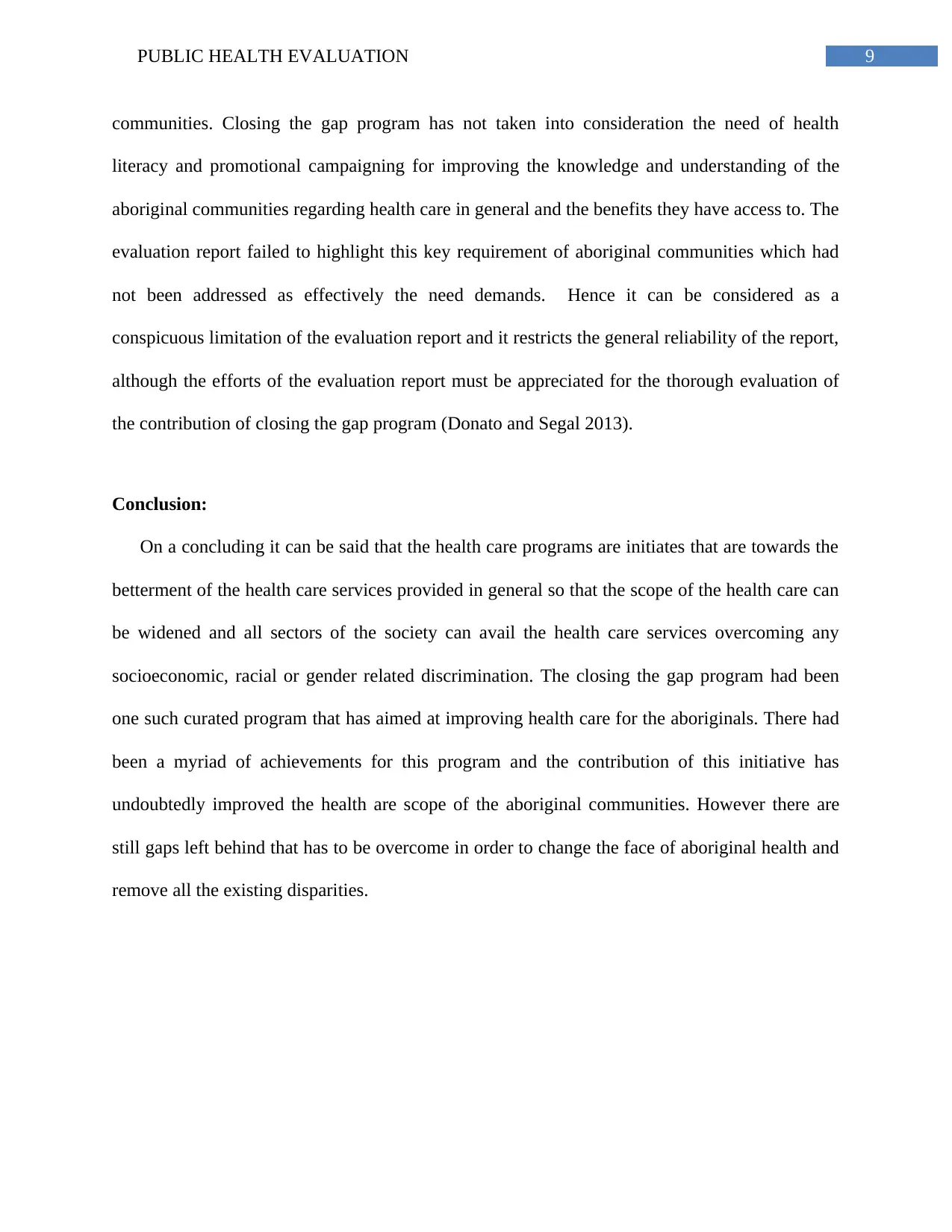
9PUBLIC HEALTH EVALUATION
communities. Closing the gap program has not taken into consideration the need of health
literacy and promotional campaigning for improving the knowledge and understanding of the
aboriginal communities regarding health care in general and the benefits they have access to. The
evaluation report failed to highlight this key requirement of aboriginal communities which had
not been addressed as effectively the need demands. Hence it can be considered as a
conspicuous limitation of the evaluation report and it restricts the general reliability of the report,
although the efforts of the evaluation report must be appreciated for the thorough evaluation of
the contribution of closing the gap program (Donato and Segal 2013).
Conclusion:
On a concluding it can be said that the health care programs are initiates that are towards the
betterment of the health care services provided in general so that the scope of the health care can
be widened and all sectors of the society can avail the health care services overcoming any
socioeconomic, racial or gender related discrimination. The closing the gap program had been
one such curated program that has aimed at improving health care for the aboriginals. There had
been a myriad of achievements for this program and the contribution of this initiative has
undoubtedly improved the health are scope of the aboriginal communities. However there are
still gaps left behind that has to be overcome in order to change the face of aboriginal health and
remove all the existing disparities.
communities. Closing the gap program has not taken into consideration the need of health
literacy and promotional campaigning for improving the knowledge and understanding of the
aboriginal communities regarding health care in general and the benefits they have access to. The
evaluation report failed to highlight this key requirement of aboriginal communities which had
not been addressed as effectively the need demands. Hence it can be considered as a
conspicuous limitation of the evaluation report and it restricts the general reliability of the report,
although the efforts of the evaluation report must be appreciated for the thorough evaluation of
the contribution of closing the gap program (Donato and Segal 2013).
Conclusion:
On a concluding it can be said that the health care programs are initiates that are towards the
betterment of the health care services provided in general so that the scope of the health care can
be widened and all sectors of the society can avail the health care services overcoming any
socioeconomic, racial or gender related discrimination. The closing the gap program had been
one such curated program that has aimed at improving health care for the aboriginals. There had
been a myriad of achievements for this program and the contribution of this initiative has
undoubtedly improved the health are scope of the aboriginal communities. However there are
still gaps left behind that has to be overcome in order to change the face of aboriginal health and
remove all the existing disparities.
Paraphrase This Document
Need a fresh take? Get an instant paraphrase of this document with our AI Paraphraser
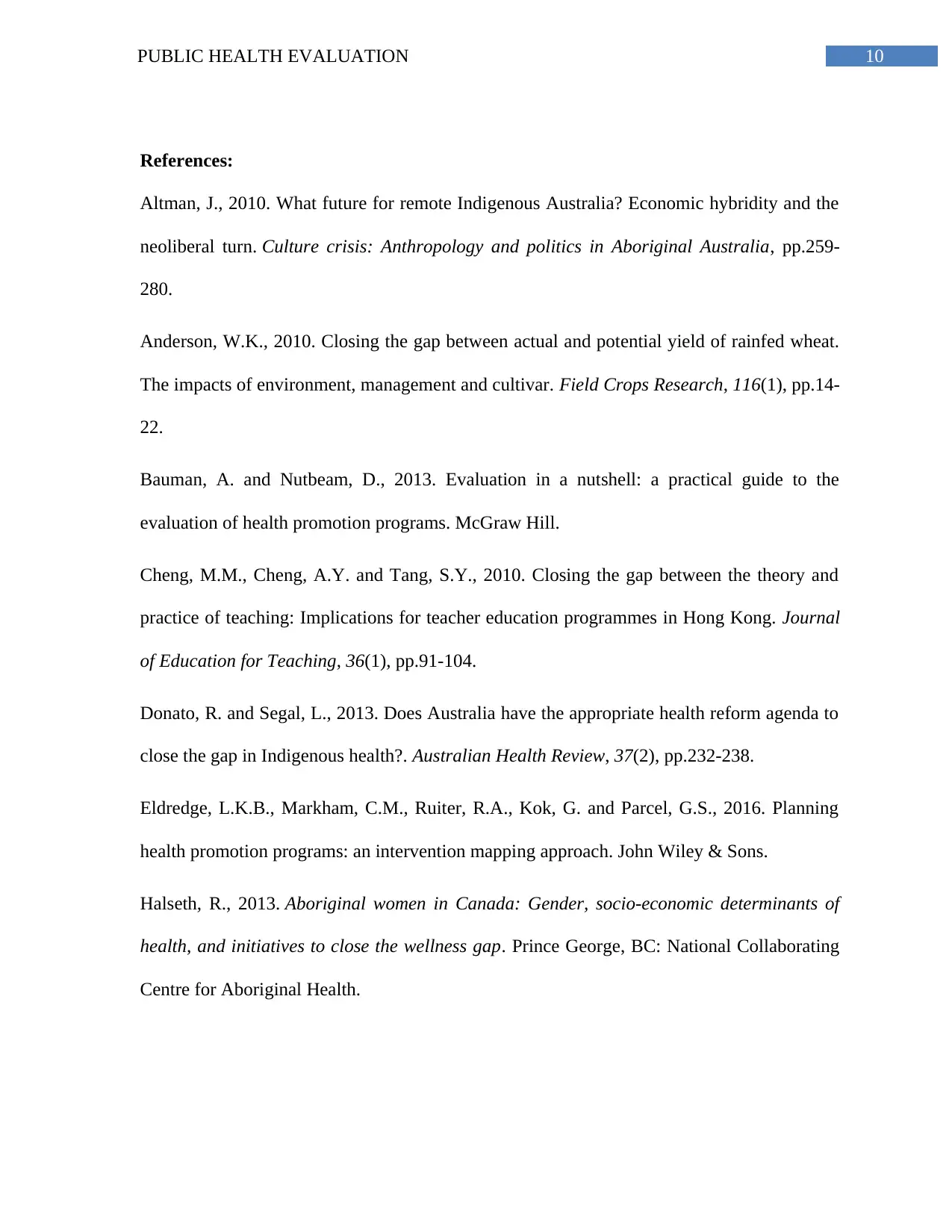
10PUBLIC HEALTH EVALUATION
References:
Altman, J., 2010. What future for remote Indigenous Australia? Economic hybridity and the
neoliberal turn. Culture crisis: Anthropology and politics in Aboriginal Australia, pp.259-
280.
Anderson, W.K., 2010. Closing the gap between actual and potential yield of rainfed wheat.
The impacts of environment, management and cultivar. Field Crops Research, 116(1), pp.14-
22.
Bauman, A. and Nutbeam, D., 2013. Evaluation in a nutshell: a practical guide to the
evaluation of health promotion programs. McGraw Hill.
Cheng, M.M., Cheng, A.Y. and Tang, S.Y., 2010. Closing the gap between the theory and
practice of teaching: Implications for teacher education programmes in Hong Kong. Journal
of Education for Teaching, 36(1), pp.91-104.
Donato, R. and Segal, L., 2013. Does Australia have the appropriate health reform agenda to
close the gap in Indigenous health?. Australian Health Review, 37(2), pp.232-238.
Eldredge, L.K.B., Markham, C.M., Ruiter, R.A., Kok, G. and Parcel, G.S., 2016. Planning
health promotion programs: an intervention mapping approach. John Wiley & Sons.
Halseth, R., 2013. Aboriginal women in Canada: Gender, socio-economic determinants of
health, and initiatives to close the wellness gap. Prince George, BC: National Collaborating
Centre for Aboriginal Health.
References:
Altman, J., 2010. What future for remote Indigenous Australia? Economic hybridity and the
neoliberal turn. Culture crisis: Anthropology and politics in Aboriginal Australia, pp.259-
280.
Anderson, W.K., 2010. Closing the gap between actual and potential yield of rainfed wheat.
The impacts of environment, management and cultivar. Field Crops Research, 116(1), pp.14-
22.
Bauman, A. and Nutbeam, D., 2013. Evaluation in a nutshell: a practical guide to the
evaluation of health promotion programs. McGraw Hill.
Cheng, M.M., Cheng, A.Y. and Tang, S.Y., 2010. Closing the gap between the theory and
practice of teaching: Implications for teacher education programmes in Hong Kong. Journal
of Education for Teaching, 36(1), pp.91-104.
Donato, R. and Segal, L., 2013. Does Australia have the appropriate health reform agenda to
close the gap in Indigenous health?. Australian Health Review, 37(2), pp.232-238.
Eldredge, L.K.B., Markham, C.M., Ruiter, R.A., Kok, G. and Parcel, G.S., 2016. Planning
health promotion programs: an intervention mapping approach. John Wiley & Sons.
Halseth, R., 2013. Aboriginal women in Canada: Gender, socio-economic determinants of
health, and initiatives to close the wellness gap. Prince George, BC: National Collaborating
Centre for Aboriginal Health.
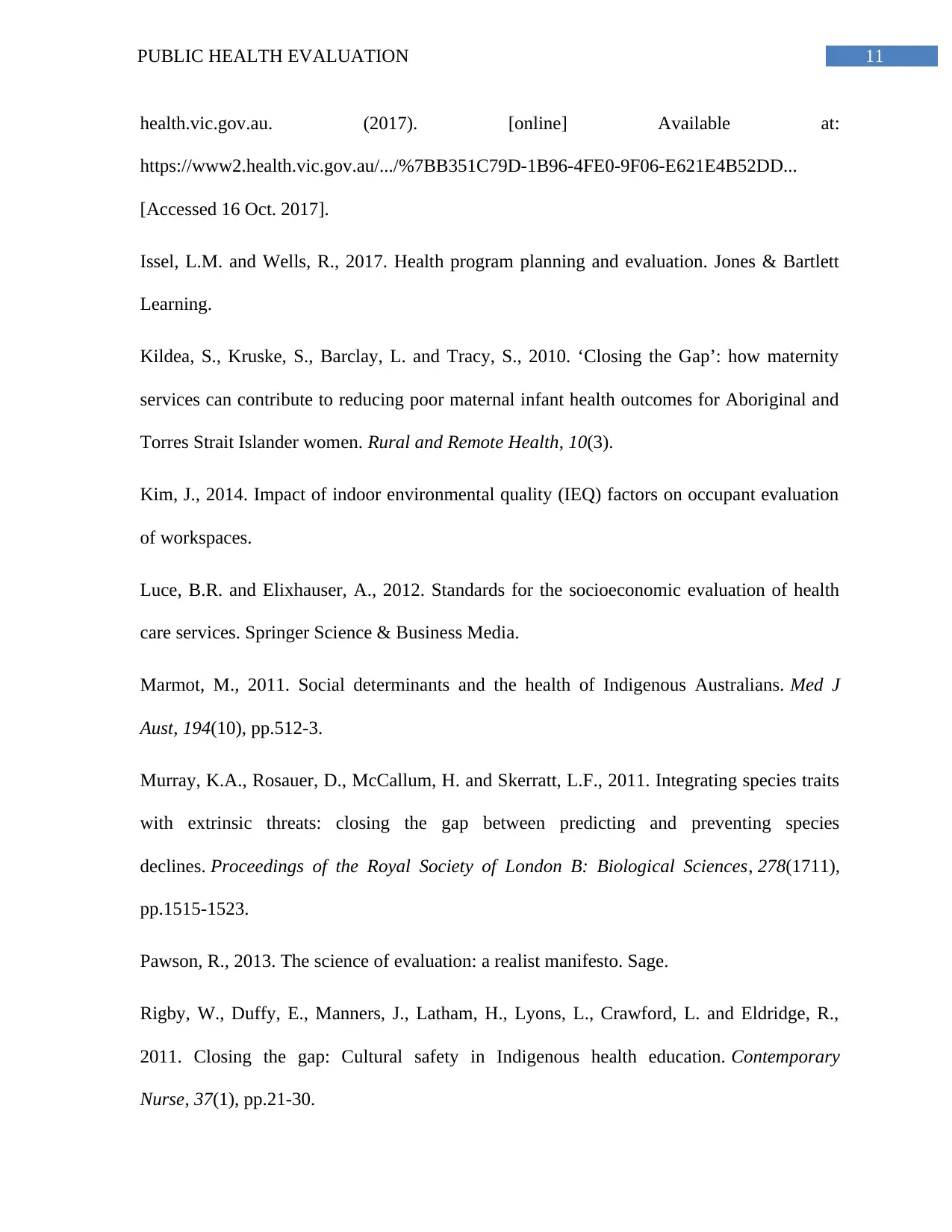
11PUBLIC HEALTH EVALUATION
health.vic.gov.au. (2017). [online] Available at:
https://www2.health.vic.gov.au/.../%7BB351C79D-1B96-4FE0-9F06-E621E4B52DD...
[Accessed 16 Oct. 2017].
Issel, L.M. and Wells, R., 2017. Health program planning and evaluation. Jones & Bartlett
Learning.
Kildea, S., Kruske, S., Barclay, L. and Tracy, S., 2010. ‘Closing the Gap’: how maternity
services can contribute to reducing poor maternal infant health outcomes for Aboriginal and
Torres Strait Islander women. Rural and Remote Health, 10(3).
Kim, J., 2014. Impact of indoor environmental quality (IEQ) factors on occupant evaluation
of workspaces.
Luce, B.R. and Elixhauser, A., 2012. Standards for the socioeconomic evaluation of health
care services. Springer Science & Business Media.
Marmot, M., 2011. Social determinants and the health of Indigenous Australians. Med J
Aust, 194(10), pp.512-3.
Murray, K.A., Rosauer, D., McCallum, H. and Skerratt, L.F., 2011. Integrating species traits
with extrinsic threats: closing the gap between predicting and preventing species
declines. Proceedings of the Royal Society of London B: Biological Sciences, 278(1711),
pp.1515-1523.
Pawson, R., 2013. The science of evaluation: a realist manifesto. Sage.
Rigby, W., Duffy, E., Manners, J., Latham, H., Lyons, L., Crawford, L. and Eldridge, R.,
2011. Closing the gap: Cultural safety in Indigenous health education. Contemporary
Nurse, 37(1), pp.21-30.
health.vic.gov.au. (2017). [online] Available at:
https://www2.health.vic.gov.au/.../%7BB351C79D-1B96-4FE0-9F06-E621E4B52DD...
[Accessed 16 Oct. 2017].
Issel, L.M. and Wells, R., 2017. Health program planning and evaluation. Jones & Bartlett
Learning.
Kildea, S., Kruske, S., Barclay, L. and Tracy, S., 2010. ‘Closing the Gap’: how maternity
services can contribute to reducing poor maternal infant health outcomes for Aboriginal and
Torres Strait Islander women. Rural and Remote Health, 10(3).
Kim, J., 2014. Impact of indoor environmental quality (IEQ) factors on occupant evaluation
of workspaces.
Luce, B.R. and Elixhauser, A., 2012. Standards for the socioeconomic evaluation of health
care services. Springer Science & Business Media.
Marmot, M., 2011. Social determinants and the health of Indigenous Australians. Med J
Aust, 194(10), pp.512-3.
Murray, K.A., Rosauer, D., McCallum, H. and Skerratt, L.F., 2011. Integrating species traits
with extrinsic threats: closing the gap between predicting and preventing species
declines. Proceedings of the Royal Society of London B: Biological Sciences, 278(1711),
pp.1515-1523.
Pawson, R., 2013. The science of evaluation: a realist manifesto. Sage.
Rigby, W., Duffy, E., Manners, J., Latham, H., Lyons, L., Crawford, L. and Eldridge, R.,
2011. Closing the gap: Cultural safety in Indigenous health education. Contemporary
Nurse, 37(1), pp.21-30.
⊘ This is a preview!⊘
Do you want full access?
Subscribe today to unlock all pages.

Trusted by 1+ million students worldwide
1 out of 13
Related Documents
Your All-in-One AI-Powered Toolkit for Academic Success.
+13062052269
info@desklib.com
Available 24*7 on WhatsApp / Email
![[object Object]](/_next/static/media/star-bottom.7253800d.svg)
Unlock your academic potential
Copyright © 2020–2025 A2Z Services. All Rights Reserved. Developed and managed by ZUCOL.




